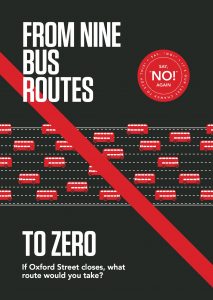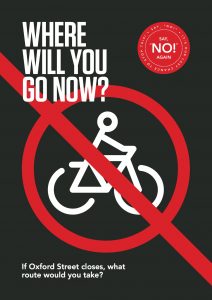A40 Oxford Street – Closure to all Traffic – Why?
Currently, Oxford Street is restricted to buses and taxis only from 07:00 – 19:00, Monday to Saturday.
Closing Oxford Street to day time traffic without understanding or dealing with the resulting overflow into adjacent areas is NOT AN OPTION
Closing Oxford Street whilst protecting surrounding areas from traffic overflow is AN UNACHIEVABLE ASPIRATION
Closing Oxford Street to achieve transformation objectives IS NOT NECESSARY
THREE MAJOR PROBLEMS WITH CLOSURE
1. BUSES- ASSUMING that by achieving certain reductions in bus numbers – 40% is promised, the remaining 162 per hour can be accommodated through surrounding areas. If so, just where are the remaining buses to be routed? WIGMORE STREET – MORTIMER STREET- IS NOT AN ACCEPTABLE ALTERNATIVE – they could not take the extra congestion, also there are no place where bus stops could be sited without causing even more congestion.
2. TAXIS- NEGLECTING to recognise that taxis if banned from Oxford Street will simply use all the adjacent streets.
3. DELIVERIES- IGNORING provision for the servicing of existing shops on Oxford Street 30 per cent of which have no rear access – so this could only be achieved by comprehensively lifting restrictions on night time deliveries which would have a devastating effect and be totally unacceptable to the larger residential population in the immediate and wider surrounding areas- the actual residential population on Oxford Street is very small, but the areas surrounding Oxford Street are home to in excess of 50,000 residents.
FOUR KEY ISSUES THAT COULD BE IMPROVED WITHOUT CLOSURE
1. AIR QUALITY
A. Buses- reduce numbers and change rest to fully zero emission on a strict timetable.
B. Taxis- bring forward date for emission compliant taxis- meantime TfL could regulate the number that use Oxford Street, by a number of methods, one could be based on emissions- only low emission vehicles would be permitted after a certain date.
C. Delivery Vehicles- impose charges for the more polluting vehicles, look at reduction in numbers through freight consolidation etc.
D. Vehicle Idling- increases pollution- stricter enforcement on this necessary.
2. PEDESTRIAN COMFORT and SAFETY
A. Pavement Widening- pedestrian accidents are mainly caused by buses, but moving the buses, just moves the accidents. Widening pavements could help confront the problem, not simply send it elsewhere.
B. Pavement clutter- surplus signage, badly positioned street furniture, all impede pedestrian access and need to be reviewed, changed, improved and removed entirely in some cases.
C. Pedestrian crossings- could be increased and re-balanced to give pedestrians more time to cross junctions. Consider diagonal pavement crossings at some other junctions as at Oxford Circus. In tandem with this consider enforcement and penalties for crossing at non-designated areas.
D. Tube Access- consider introducing step-free access at Marble Arch and Oxford Circus prior to any further curtailment of public transport.
E. Westminster Walking Strategy- should be implemented – particularly on Wigmore Street- Mortimer Street.
F. Traffic free days- to allow for full closure of Oxford Street on certain named days.
G. Construction works- review and rationalise road capacity and pavement capacity reduced by closures caused by construction works of all kinds.
3. PUBLIC REALM
A. Build a central reservation- on Oxford Street West, like Regent Street and Oxford Street East.
B. Lack of public toilets- with the obvious consequences. New developments must make provisions for these.
C Improved public spaces- opportunities for greening and quiet areas, improvement of existing, e.g. Return Hanover Square to a functioning Square. Resist opportunities for using them as walk through areas, protect existing trees on them.
D. Tree planting- along both sides of the street, although this would affect pavement width.
E. Art- look at further opportunities for public art.
F. Heritage- encourage shopkeepers to improve their shopfronts and exteriors generally, the older buildings to better reflect their heritage, discourage bland plastic signs which tend to give cheap and nasty appearance.
4. IMPROVED REGULATIONS and ENFORCEMENT
A. Enforcement of banned traffic- WCC have not been prosecuting banned vehicles from using Oxford Street, as a result there is a certain amount of illegal traffic using it, which could be removed – needs investment in cameras.
B. Buskers and Street Traders- proper and more effective control is needed, their activities often narrow the pavements at the busiest places, e.g. in front of the station entrances and exits
C. Pedi-cabs- need to banned or strictly regulated, they are a significant source of congestion on Oxford Street.
D. Deliveries- 30% of shops need access for deliveries directly from Oxford Street- freight consolidation should be considered as it has been in Regent Street to reduce number of vehicles servicing shops.
E. Sunday free parking- This simply encourages people to drive in, introduces more congestion and clutter- this should be reviewed urgently.
NONE OF THE ABOVE NEED CLOSURE TO IMPLEMENT
SEVEN POSITIVE ADVANTAGES TO KEEPING OXFORD STREET OPEN
1. GREATER PUBLIC SAFETY- in allowing emergency services easier access to Oxford Street (surrounding congestion caused by its closure will greatly impede this). Less opportunity for terrorist attacks with vehicles – as we have seen pedestrian only streets are more open to this threat.
2. CONTROL AND ENFORCEMENT- i.e. busking and street performers- WCC already find this very difficult to control – how much more so when you have a Trafalgar Square type environment attracting huge numbers of street entertainers and the criminal element that goes with them.
3. SAFEGUARD TRADING- traffic is lifeblood for shops in a long street such as Oxford Street, it is essential to have transport to get to and from, for the old, the disabled, for those with heavy shopping, it is needed for deliveries, and very convenient for the rest.
We thought NWEC had learned the lesson that increased footfall is very different from generating increased sales, from the failure of traffic free days to generate meaningful increases in revenue. Economically if Oxford Street is closed it is quite likely that many who previously travelled to it to actually shop will be put off, not least by the pollution and congestion getting there, and will prefer the nearby alternatives, such as Brent Cross, and the Westfield Centres at Shepherds Bush and Stratford.
Oxford Street far from seeing increases, could actually lose revenue. Indeed those they are in most danger of driving away are the highest spending demographic- do they really think that these people will be willing to sit in Taxis trying to get through the congestion and pollution in the surrounding areas only to be told that they will need to get out and walk for the final half mile?
4. PROTECTION OF SURROUNDING AREAS- from additional pollution and congestion caused by traffic displaced from Oxford Street.
5. ELIZABETH LINE- opens in 2018 – the assumption is that this will decant large extra numbers into Oxford Street- but this is mere assumption without proper research. There is a strong argument for a wait and see policy to find out what actually happens rather than a knee jerk reaction, for instance the Elizabeth line will result in reduced stress on Central Line and key stations.
6. LESS CRIME- Night-time safety due to traffic flow – crime enforcement, much easier on a street with traffic, less opportunities for crime on a street with traffic, less shelter spots, more likelihood of being seen.
7. ALLOW TIME TO ASSESS ADDITIONAL IMPACTS FROM MAJOR ROAD CHANGES IN THE AREA- all coming into being around the same time as proposed changes to Oxford Street – and all threaten further congestion in one form or another:
Baker Street Two Way
Tottenham Court Road Closure to all traffic except buses, and cyclists and reversion to two way Gower Street reversion to two way (i.e. impact of the Camden’s West End Project needs to be assessed).
High Speed 2 works.
Cycle Super Highway 11- proposed closure of Regent Park Gates.
Cycle Quietways.
IMPROVING THE SURROUNDING AREAS
CHANGES THAT COULD IMPROVE SURROUNDING AREAS WHILE KEEPING OXFORD STREET OPEN:
Air monitoring on surrounding streets- poor air quality- it is not only Oxford Street that has poor air quality, all the surrounding areas regularly exceed EU guidelines both on NoX emission and particulate matter (PM). We need a baseline study now to get better statistics on pollution hotspots around the area. We are taking steps to commence monitoring NoX emissions in the area around Oxford Street in order to find out more about this.
Change buses- to fully zero emission.
Bring forward emission controls- on all diesel vehicles, including taxis.
Open side streets- closed by Crossrail works.
Remove build-out at Oxford Circus- to allow bus lane southbound (current build out used by buskers) removing the pinch point this has introduced which causes increased congestion and pollution from queuing traffic in Upper Regent Street.
Consider designated cycle lanes- for cyclists on streets parallel with Oxford Street.
Wigmore Street (east) convert to two way- to ease flow of traffic and stop unnecessary circuitous journeys.
Public spaces- look at opportunities for improved public spaces in the area
Taxi touting- generates a considerable amount of unnecessary milage and hence more pollution – in addition private hire pay no congestion charge – this should be reviewed.
SUMMARY
Closure brings with it many problems and difficulties- that many agencies have been struggling with for 50 years now, since closure was first proposed. Until now they appeared insuperable.
WHICH IS WHY IT HAS NEVER BEEN DONE.
Now suddenly it’s on the agenda, to be rushed through before we even know how Crossrail will affect public transport in the area. Indeed until 2 years ago TfL led the chorus of doubters against it saying such a venture was impracticable on a number of levels. It only had one major proponent, the New West End Company. Then, even they appeared to give up on it.
SO WHAT HAS CHANGED?
Why has TfL suddenly had a change of heart, in the face of opposition from nearly all local stakeholders, business (excluding the larger stores) and residents?
AND WHY IS THIS BEING RUSHED THROUGH WITH SO LITTLE TIME TO PLAN AND IMPLEMENT?
BECAUSE it is for the first time on the political agenda: the present Mayor made a promise to do it, so actual viability is now replaced with political expediency, mere overwhelming weight of evidence against this project is no longer sufficient to deter.
BUT THIS SCHEME RESTS ON A DISCREDITED ASSUMPTION
It relies on the arcane theory, or hope, of TRAFFIC EVAPORATION- that is that if a street is closed or restricted the traffic that used it will simply disappear, rather than clog up surrounding areas. This is a fallacy on which TfL have based much of their modelling for the the Cycle Superhighways, which we have seen fail on the Embankment, on Bayswater Road in Hyde Park and elsewhere. There is now more pollution and congestion in these areas than before they were built.
The truth is that the vast majority of traffic left that now uses Oxford Street will not disappear if that route through central London is closed. The private motorist is no longer the issue and has been largely removed and what remains will need to find a way through. The proposed closure of the A40 – Oxford Street, will have a major and unacceptable impact on all those streets around it.
THERE IS MAJOR SCOPE FOR IMPROVEMENT OF OXFORD STREET WITHOUT CLOSURE
THERE ARE POSITIVE ADVANTAGES TO KEEPING TRAFFIC ON OXFORD STREET
WHY BLIGHT SURROUNDING AREAS TO ACHIEVE DUBIOUS AND UNPROVEN BENEFITS TO ONE SHOPPING STREET?


